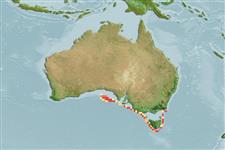Klassifizierung / Names
Namen | Synonyme | Catalog of Fishes(Gattung, Arten) | ITIS | CoL | WoRMS | Cloffa
Elasmobranchii (Haie und Rochen) (sharks and rays) >
Rajiformes (Skates and rays) >
Rajidae (Skates)
Etymology: Rajella: Latin, raja, -ae = a sting ray (Raja sp.) (Ref. 45335); challengeri: Named for FRV Challenger, used to survey the deepwater demersal fish resources of Tasmania in the 1980s..
More on authors: Last & Stehmann.
Environment: milieu / climate zone / depth range / distribution range
Ökologie
seewasser benthopelagisch; tiefenbereich 860 - 1500 m (Ref. 114953). Tropical; 32°S - 45°S, 130°E - 154°E (Ref. 114953)
Eastern Indian Ocean and Southwest Pacific: New South Wales to Great Australian Bight (Australia) (Ref. 114953).
Size / Gewicht / Alter
Maturity: Lm ? range ? - ? cm
Max length : 56.1 cm TL Männchen/unbestimmt; (Ref. 75644)
A benthic species on continental slope (Ref. 114953). Observed to be still a juvenile at 49.5 cm TL, smallest at 16.7 cm TL, adult males 52.1-56.1 cm TL (Ref. 75644).
Life cycle and mating behavior
Geschlechtsreife | Fortpflanzung | Ablaichen | Eier | Fecundity | Larven
Last, P.R. and M.F.W. Stehmann, 2008. Rajella challengeri sp. nov., a new deepwater skate from southern Australia. pp. 135-144. In Last, P.R., W.T. White, J.J. Pogonoski and D.C. Gledhill (eds.): Descriptions of new Australian skates (Batoidea: Rajoidei) pg. 135-144. CSIRO marine and atmospheric research paper no. 021. (Ref. 75644)
IUCN Rote Liste Status (Ref. 130435)
Bedrohung für Menschen
Harmless
Nutzung durch Menschen
Mehr Information
NamenSynonymeMetabolismusRäuberÖkotoxikologieFortpflanzungGeschlechtsreifeAblaichenSpawning aggregationFecundityEierEientwicklung
Alter/Größe
Wachstum
Länge-Gewicht
Länge-Länge
Längenhäufigkeiten
Morphometrie
Morphologie
Larven
Larven Pop.Dyn.
Rekrutierung
Dichte
BRUVS
ReferenzenAquakulturAquakultur ProfilZuchtlinienGenetikElectrophoresesVererbbarkeitKrankheitenVerarbeitungNutrientsMass conversion
PartnerBilderStamps, Coins Misc.LauteCiguateraGeschwindigkeitSchwimmstilKiemenoberflächeOtolithsGehirngrößeSehfähigkeit
Tools
Zusatzinformationen
Download XML
Internet Quellen
Estimates based on models
Preferred temperature (Ref.
123201): 2 - 5, mean 4.3 °C (based on 39 cells).
Phylogenetic diversity index (Ref.
82804): PD
50 = 0.5000 [Uniqueness, from 0.5 = low to 2.0 = high].
Bayesian length-weight: a=0.00302 (0.00141 - 0.00645), b=3.24 (3.07 - 3.41), in cm total length, based on LWR estimates for this (Sub)family-body shape (Ref.
93245).
Trophic level (Ref.
69278): 3.6 ±0.5 se; based on size and trophs of closest relatives
Widerstandsfähigkeit (Ref.
120179): niedrig, Verdopplung der Population dauert 4,5 - 14 Jahre. (Preliminary low fecundity).
Fishing Vulnerability (Ref.
59153): Moderate vulnerability (42 of 100).
